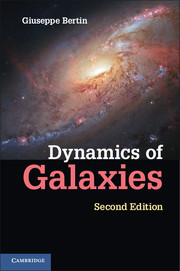Book contents
- Frontmatter
- Contents
- Preface to the Second Edition
- Preface to the First Edition, 2000
- Acknowledgments
- PART I Basic Phenomenology
- PART II Physical Models
- PART III Spiral Galaxies
- 13 Orbits
- 14 The Basic State: Vertical and Horizontal Equilibrium of the Disk
- 15 Density Waves
- 16 Roles of Gas
- 17 Global Spiral Modes
- 18 Spiral Structure in Galaxies
- 19 Bending Waves
- 20 Dark Matter in Spiral Galaxies
- PART IV Elliptical Galaxies
- PART V In Perspective
- Bibliography
- Index of objects
- Index
14 - The Basic State: Vertical and Horizontal Equilibrium of the Disk
from PART III - Spiral Galaxies
Published online by Cambridge University Press: 05 June 2014
- Frontmatter
- Contents
- Preface to the Second Edition
- Preface to the First Edition, 2000
- Acknowledgments
- PART I Basic Phenomenology
- PART II Physical Models
- PART III Spiral Galaxies
- 13 Orbits
- 14 The Basic State: Vertical and Horizontal Equilibrium of the Disk
- 15 Density Waves
- 16 Roles of Gas
- 17 Global Spiral Modes
- 18 Spiral Structure in Galaxies
- 19 Bending Waves
- 20 Dark Matter in Spiral Galaxies
- PART IV Elliptical Galaxies
- PART V In Perspective
- Bibliography
- Index of objects
- Index
Summary
As described in Chapter 9, the concept of the basic state is a key step in the modeling process. As in other contexts, for galaxy disks, identification of an appropriate basic state is done for several purposes. One interesting aspect is that by studying the internal structure of the basic state, we can clarify the overall constraints imposed by self-consistency; in this respect, the two examples that follow, dealing with the vertical and horizontal equilibrium of a rotation-supported disk, are rather simple (in collisionless stellar dynamics, self-consistency imposes much stronger and less intuitive constraints in pressure-supported systems) but very instructive. The models that are set up can then be used to fit the data and thus derive information on the structure of galaxies. Furthermore, a broad choice of equilibrium models can form the basis for systematic stability analyses. In this case, the basic state is meant to be a tool to study evolution, but it should not be assumed to represent necessarily the actual conditions of the galaxy in the distant past.
From the point of view of stellar dynamics, the case of axisymmetric galaxy disks is relatively simple, because for realistic models most orbits are quasi-circular and the disk is rather thin. The related description can then be decoupled at two different levels: (1) the vertical dynamics can be treated separately from the horizontal dynamics; and (2) for the horizontal structure, because the angular momentum essentially identifies the radial coordinate, the problem of self-consistency can be worked out in two separate steps: (2.1) choose a density-potential pair, and (2.2) find a (quasi-Maxwellian) distribution function that supports the assumed density. In contrast, this procedure of going from ρ to f would generally lead to nonphysical models in the spherical case.
- Type
- Chapter
- Information
- Dynamics of Galaxies , pp. 162 - 183Publisher: Cambridge University PressPrint publication year: 2014



